Role of Talent Management in Starbucks Culture Change Research
VerifiedAdded on 2023/01/05
|27
|6408
|63
Report
AI Summary
This research project investigates the role of talent management in driving culture change, specifically using Starbucks as a case study. The report begins by defining talent management and its significance in attracting, retaining, and developing employees. It then presents the rationale, aim, and objectives of the research, which include examining the benefits of talent management, determining its role in cultural shifts, and analyzing associated complexities. A comprehensive literature review explores the advantages of talent management, such as improved hiring methodologies, employee retention, and development of consistent performers, alongside its role in organizational culture change. The research methodology section details the research approach, which is interpretivism, and data collection methods, including primary and secondary research. The report discusses the complexities businesses face in talent management, such as poor hiring strategies, ineffective leadership, and high employee turnover, and suggests ways to overcome these challenges. The project aims to provide a detailed overview of talent management's impact on culture change, offering valuable insights for businesses seeking to enhance their talent strategies and improve organizational culture.
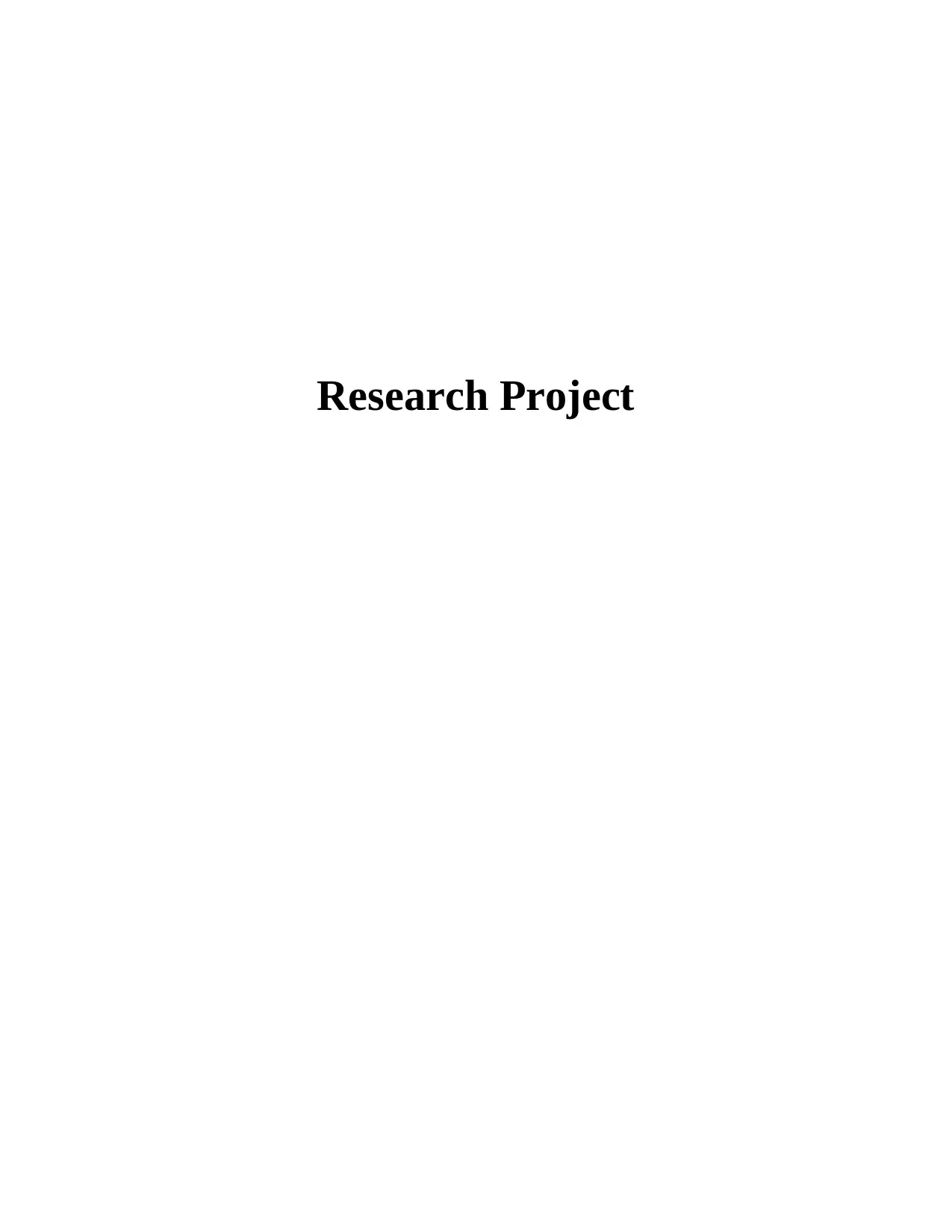
Research Project
Paraphrase This Document
Need a fresh take? Get an instant paraphrase of this document with our AI Paraphraser
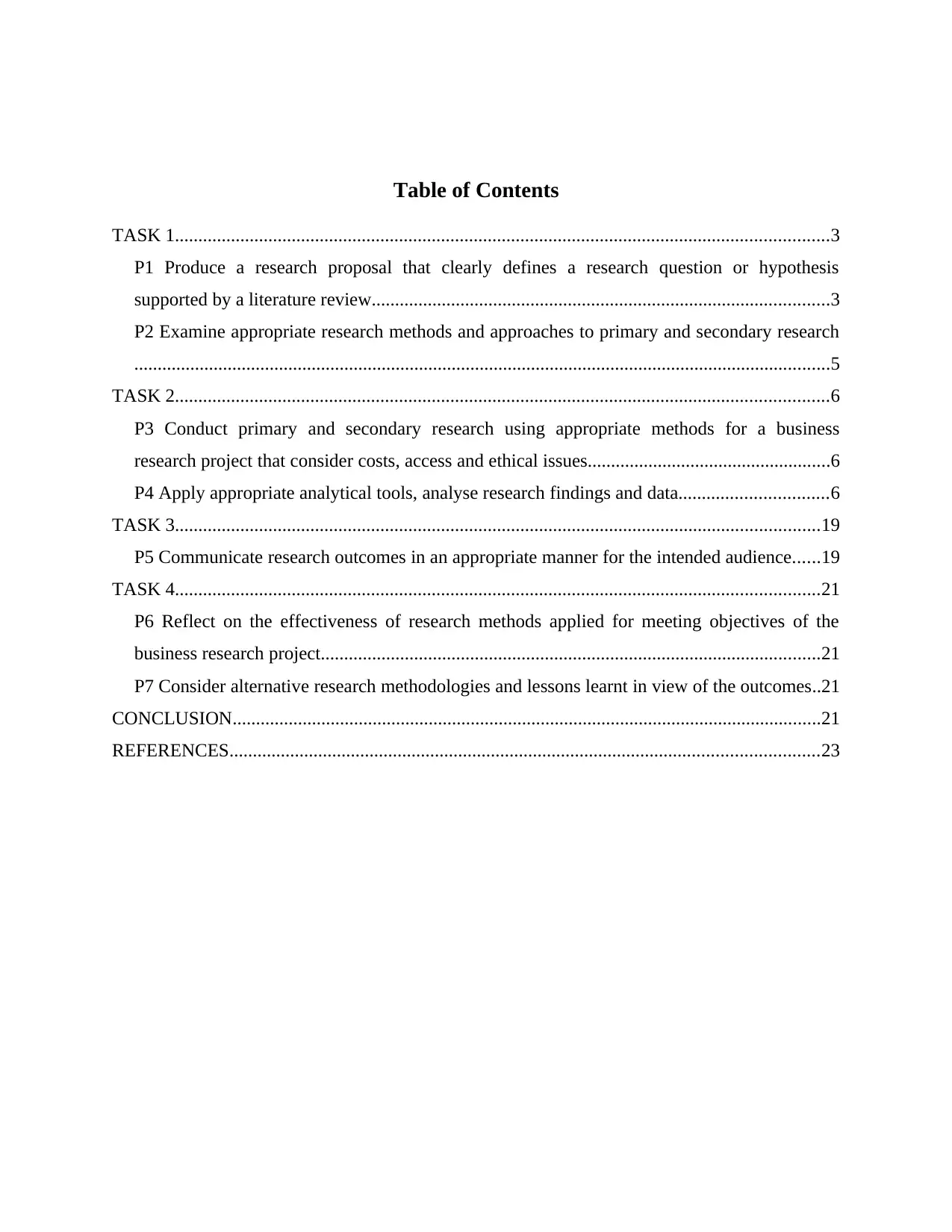
Table of Contents
TASK 1............................................................................................................................................3
P1 Produce a research proposal that clearly defines a research question or hypothesis
supported by a literature review..................................................................................................3
P2 Examine appropriate research methods and approaches to primary and secondary research
.....................................................................................................................................................5
TASK 2............................................................................................................................................6
P3 Conduct primary and secondary research using appropriate methods for a business
research project that consider costs, access and ethical issues....................................................6
P4 Apply appropriate analytical tools, analyse research findings and data................................6
TASK 3..........................................................................................................................................19
P5 Communicate research outcomes in an appropriate manner for the intended audience......19
TASK 4..........................................................................................................................................21
P6 Reflect on the effectiveness of research methods applied for meeting objectives of the
business research project...........................................................................................................21
P7 Consider alternative research methodologies and lessons learnt in view of the outcomes..21
CONCLUSION..............................................................................................................................21
REFERENCES..............................................................................................................................23
TASK 1............................................................................................................................................3
P1 Produce a research proposal that clearly defines a research question or hypothesis
supported by a literature review..................................................................................................3
P2 Examine appropriate research methods and approaches to primary and secondary research
.....................................................................................................................................................5
TASK 2............................................................................................................................................6
P3 Conduct primary and secondary research using appropriate methods for a business
research project that consider costs, access and ethical issues....................................................6
P4 Apply appropriate analytical tools, analyse research findings and data................................6
TASK 3..........................................................................................................................................19
P5 Communicate research outcomes in an appropriate manner for the intended audience......19
TASK 4..........................................................................................................................................21
P6 Reflect on the effectiveness of research methods applied for meeting objectives of the
business research project...........................................................................................................21
P7 Consider alternative research methodologies and lessons learnt in view of the outcomes..21
CONCLUSION..............................................................................................................................21
REFERENCES..............................................................................................................................23
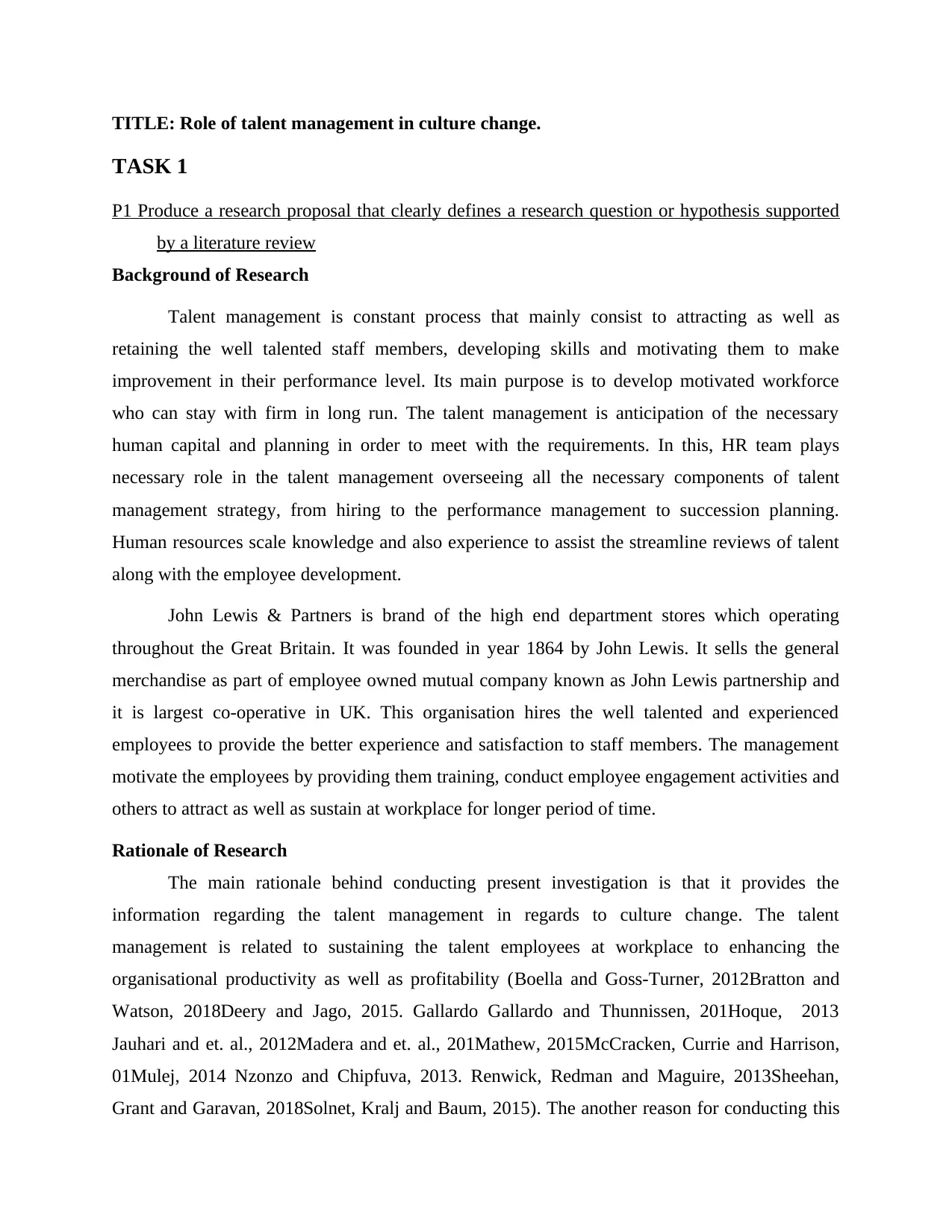
TITLE: Role of talent management in culture change.
TASK 1
P1 Produce a research proposal that clearly defines a research question or hypothesis supported
by a literature review
Background of Research
Talent management is constant process that mainly consist to attracting as well as
retaining the well talented staff members, developing skills and motivating them to make
improvement in their performance level. Its main purpose is to develop motivated workforce
who can stay with firm in long run. The talent management is anticipation of the necessary
human capital and planning in order to meet with the requirements. In this, HR team plays
necessary role in the talent management overseeing all the necessary components of talent
management strategy, from hiring to the performance management to succession planning.
Human resources scale knowledge and also experience to assist the streamline reviews of talent
along with the employee development.
John Lewis & Partners is brand of the high end department stores which operating
throughout the Great Britain. It was founded in year 1864 by John Lewis. It sells the general
merchandise as part of employee owned mutual company known as John Lewis partnership and
it is largest co-operative in UK. This organisation hires the well talented and experienced
employees to provide the better experience and satisfaction to staff members. The management
motivate the employees by providing them training, conduct employee engagement activities and
others to attract as well as sustain at workplace for longer period of time.
Rationale of Research
The main rationale behind conducting present investigation is that it provides the
information regarding the talent management in regards to culture change. The talent
management is related to sustaining the talent employees at workplace to enhancing the
organisational productivity as well as profitability (Boella and Goss-Turner, 2012Bratton and
Watson, 2018Deery and Jago, 2015. Gallardo Gallardo and Thunnissen, 201Hoque, 2013
Jauhari and et. al., 2012Madera and et. al., 201Mathew, 2015McCracken, Currie and Harrison,
01Mulej, 2014 Nzonzo and Chipfuva, 2013. Renwick, Redman and Maguire, 2013Sheehan,
Grant and Garavan, 2018Solnet, Kralj and Baum, 2015). The another reason for conducting this
TASK 1
P1 Produce a research proposal that clearly defines a research question or hypothesis supported
by a literature review
Background of Research
Talent management is constant process that mainly consist to attracting as well as
retaining the well talented staff members, developing skills and motivating them to make
improvement in their performance level. Its main purpose is to develop motivated workforce
who can stay with firm in long run. The talent management is anticipation of the necessary
human capital and planning in order to meet with the requirements. In this, HR team plays
necessary role in the talent management overseeing all the necessary components of talent
management strategy, from hiring to the performance management to succession planning.
Human resources scale knowledge and also experience to assist the streamline reviews of talent
along with the employee development.
John Lewis & Partners is brand of the high end department stores which operating
throughout the Great Britain. It was founded in year 1864 by John Lewis. It sells the general
merchandise as part of employee owned mutual company known as John Lewis partnership and
it is largest co-operative in UK. This organisation hires the well talented and experienced
employees to provide the better experience and satisfaction to staff members. The management
motivate the employees by providing them training, conduct employee engagement activities and
others to attract as well as sustain at workplace for longer period of time.
Rationale of Research
The main rationale behind conducting present investigation is that it provides the
information regarding the talent management in regards to culture change. The talent
management is related to sustaining the talent employees at workplace to enhancing the
organisational productivity as well as profitability (Boella and Goss-Turner, 2012Bratton and
Watson, 2018Deery and Jago, 2015. Gallardo Gallardo and Thunnissen, 201Hoque, 2013
Jauhari and et. al., 2012Madera and et. al., 201Mathew, 2015McCracken, Currie and Harrison,
01Mulej, 2014 Nzonzo and Chipfuva, 2013. Renwick, Redman and Maguire, 2013Sheehan,
Grant and Garavan, 2018Solnet, Kralj and Baum, 2015). The another reason for conducting this
⊘ This is a preview!⊘
Do you want full access?
Subscribe today to unlock all pages.

Trusted by 1+ million students worldwide
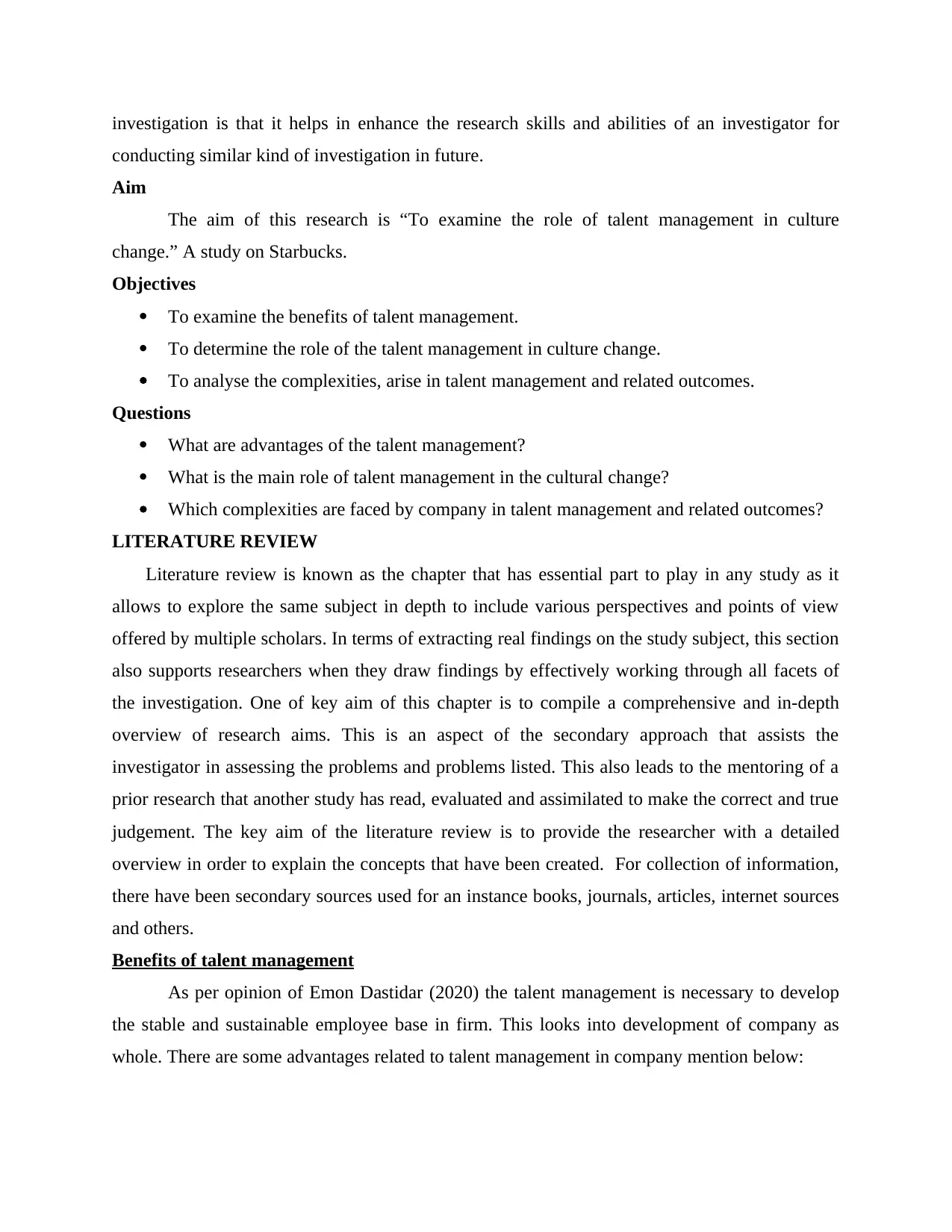
investigation is that it helps in enhance the research skills and abilities of an investigator for
conducting similar kind of investigation in future.
Aim
The aim of this research is “To examine the role of talent management in culture
change.” A study on Starbucks.
Objectives
To examine the benefits of talent management.
To determine the role of the talent management in culture change.
To analyse the complexities, arise in talent management and related outcomes.
Questions
What are advantages of the talent management?
What is the main role of talent management in the cultural change?
Which complexities are faced by company in talent management and related outcomes?
LITERATURE REVIEW
Literature review is known as the chapter that has essential part to play in any study as it
allows to explore the same subject in depth to include various perspectives and points of view
offered by multiple scholars. In terms of extracting real findings on the study subject, this section
also supports researchers when they draw findings by effectively working through all facets of
the investigation. One of key aim of this chapter is to compile a comprehensive and in-depth
overview of research aims. This is an aspect of the secondary approach that assists the
investigator in assessing the problems and problems listed. This also leads to the mentoring of a
prior research that another study has read, evaluated and assimilated to make the correct and true
judgement. The key aim of the literature review is to provide the researcher with a detailed
overview in order to explain the concepts that have been created. For collection of information,
there have been secondary sources used for an instance books, journals, articles, internet sources
and others.
Benefits of talent management
As per opinion of Emon Dastidar (2020) the talent management is necessary to develop
the stable and sustainable employee base in firm. This looks into development of company as
whole. There are some advantages related to talent management in company mention below:
conducting similar kind of investigation in future.
Aim
The aim of this research is “To examine the role of talent management in culture
change.” A study on Starbucks.
Objectives
To examine the benefits of talent management.
To determine the role of the talent management in culture change.
To analyse the complexities, arise in talent management and related outcomes.
Questions
What are advantages of the talent management?
What is the main role of talent management in the cultural change?
Which complexities are faced by company in talent management and related outcomes?
LITERATURE REVIEW
Literature review is known as the chapter that has essential part to play in any study as it
allows to explore the same subject in depth to include various perspectives and points of view
offered by multiple scholars. In terms of extracting real findings on the study subject, this section
also supports researchers when they draw findings by effectively working through all facets of
the investigation. One of key aim of this chapter is to compile a comprehensive and in-depth
overview of research aims. This is an aspect of the secondary approach that assists the
investigator in assessing the problems and problems listed. This also leads to the mentoring of a
prior research that another study has read, evaluated and assimilated to make the correct and true
judgement. The key aim of the literature review is to provide the researcher with a detailed
overview in order to explain the concepts that have been created. For collection of information,
there have been secondary sources used for an instance books, journals, articles, internet sources
and others.
Benefits of talent management
As per opinion of Emon Dastidar (2020) the talent management is necessary to develop
the stable and sustainable employee base in firm. This looks into development of company as
whole. There are some advantages related to talent management in company mention below:
Paraphrase This Document
Need a fresh take? Get an instant paraphrase of this document with our AI Paraphraser
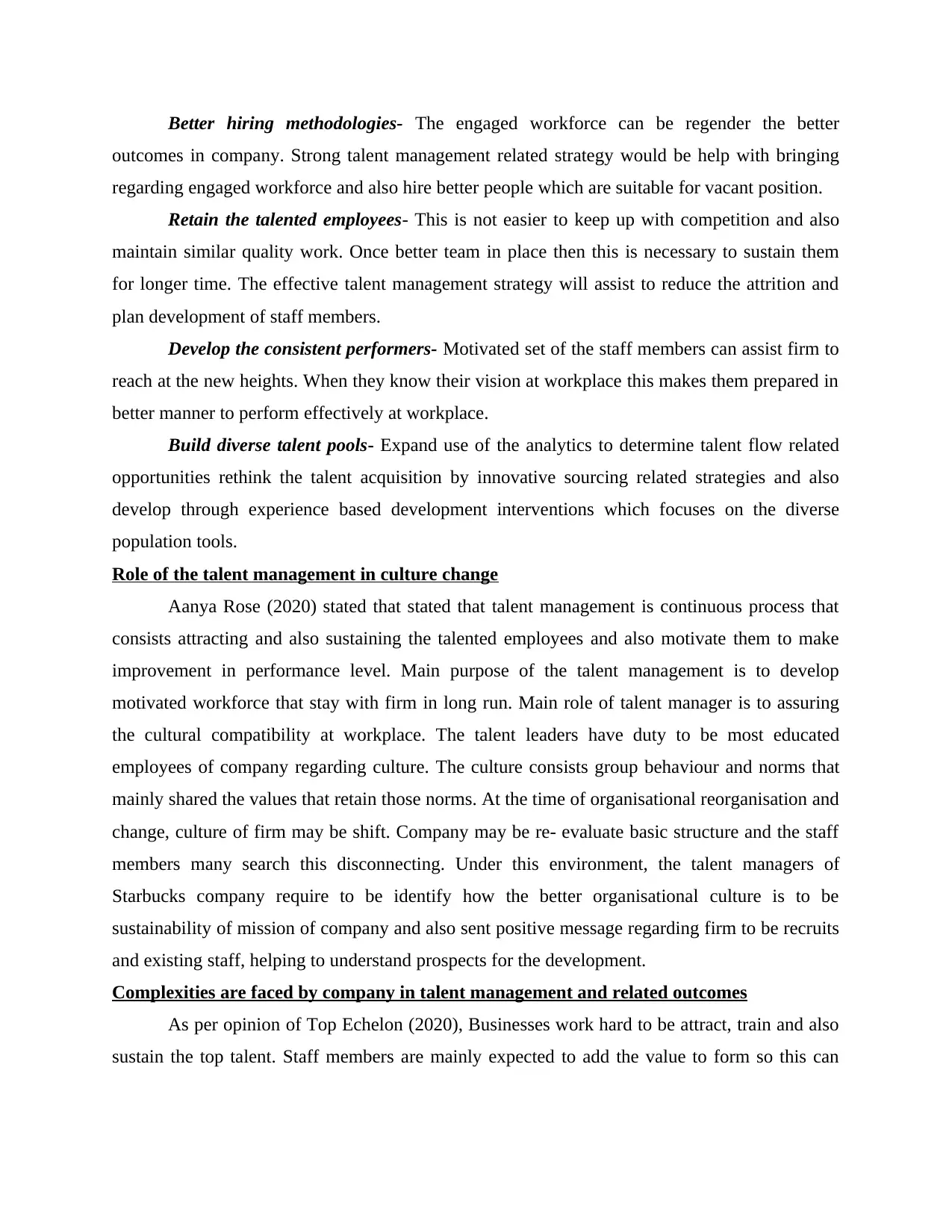
Better hiring methodologies- The engaged workforce can be regender the better
outcomes in company. Strong talent management related strategy would be help with bringing
regarding engaged workforce and also hire better people which are suitable for vacant position.
Retain the talented employees- This is not easier to keep up with competition and also
maintain similar quality work. Once better team in place then this is necessary to sustain them
for longer time. The effective talent management strategy will assist to reduce the attrition and
plan development of staff members.
Develop the consistent performers- Motivated set of the staff members can assist firm to
reach at the new heights. When they know their vision at workplace this makes them prepared in
better manner to perform effectively at workplace.
Build diverse talent pools- Expand use of the analytics to determine talent flow related
opportunities rethink the talent acquisition by innovative sourcing related strategies and also
develop through experience based development interventions which focuses on the diverse
population tools.
Role of the talent management in culture change
Aanya Rose (2020) stated that stated that talent management is continuous process that
consists attracting and also sustaining the talented employees and also motivate them to make
improvement in performance level. Main purpose of the talent management is to develop
motivated workforce that stay with firm in long run. Main role of talent manager is to assuring
the cultural compatibility at workplace. The talent leaders have duty to be most educated
employees of company regarding culture. The culture consists group behaviour and norms that
mainly shared the values that retain those norms. At the time of organisational reorganisation and
change, culture of firm may be shift. Company may be re- evaluate basic structure and the staff
members many search this disconnecting. Under this environment, the talent managers of
Starbucks company require to be identify how the better organisational culture is to be
sustainability of mission of company and also sent positive message regarding firm to be recruits
and existing staff, helping to understand prospects for the development.
Complexities are faced by company in talent management and related outcomes
As per opinion of Top Echelon (2020), Businesses work hard to be attract, train and also
sustain the top talent. Staff members are mainly expected to add the value to form so this can
outcomes in company. Strong talent management related strategy would be help with bringing
regarding engaged workforce and also hire better people which are suitable for vacant position.
Retain the talented employees- This is not easier to keep up with competition and also
maintain similar quality work. Once better team in place then this is necessary to sustain them
for longer time. The effective talent management strategy will assist to reduce the attrition and
plan development of staff members.
Develop the consistent performers- Motivated set of the staff members can assist firm to
reach at the new heights. When they know their vision at workplace this makes them prepared in
better manner to perform effectively at workplace.
Build diverse talent pools- Expand use of the analytics to determine talent flow related
opportunities rethink the talent acquisition by innovative sourcing related strategies and also
develop through experience based development interventions which focuses on the diverse
population tools.
Role of the talent management in culture change
Aanya Rose (2020) stated that stated that talent management is continuous process that
consists attracting and also sustaining the talented employees and also motivate them to make
improvement in performance level. Main purpose of the talent management is to develop
motivated workforce that stay with firm in long run. Main role of talent manager is to assuring
the cultural compatibility at workplace. The talent leaders have duty to be most educated
employees of company regarding culture. The culture consists group behaviour and norms that
mainly shared the values that retain those norms. At the time of organisational reorganisation and
change, culture of firm may be shift. Company may be re- evaluate basic structure and the staff
members many search this disconnecting. Under this environment, the talent managers of
Starbucks company require to be identify how the better organisational culture is to be
sustainability of mission of company and also sent positive message regarding firm to be recruits
and existing staff, helping to understand prospects for the development.
Complexities are faced by company in talent management and related outcomes
As per opinion of Top Echelon (2020), Businesses work hard to be attract, train and also
sustain the top talent. Staff members are mainly expected to add the value to form so this can
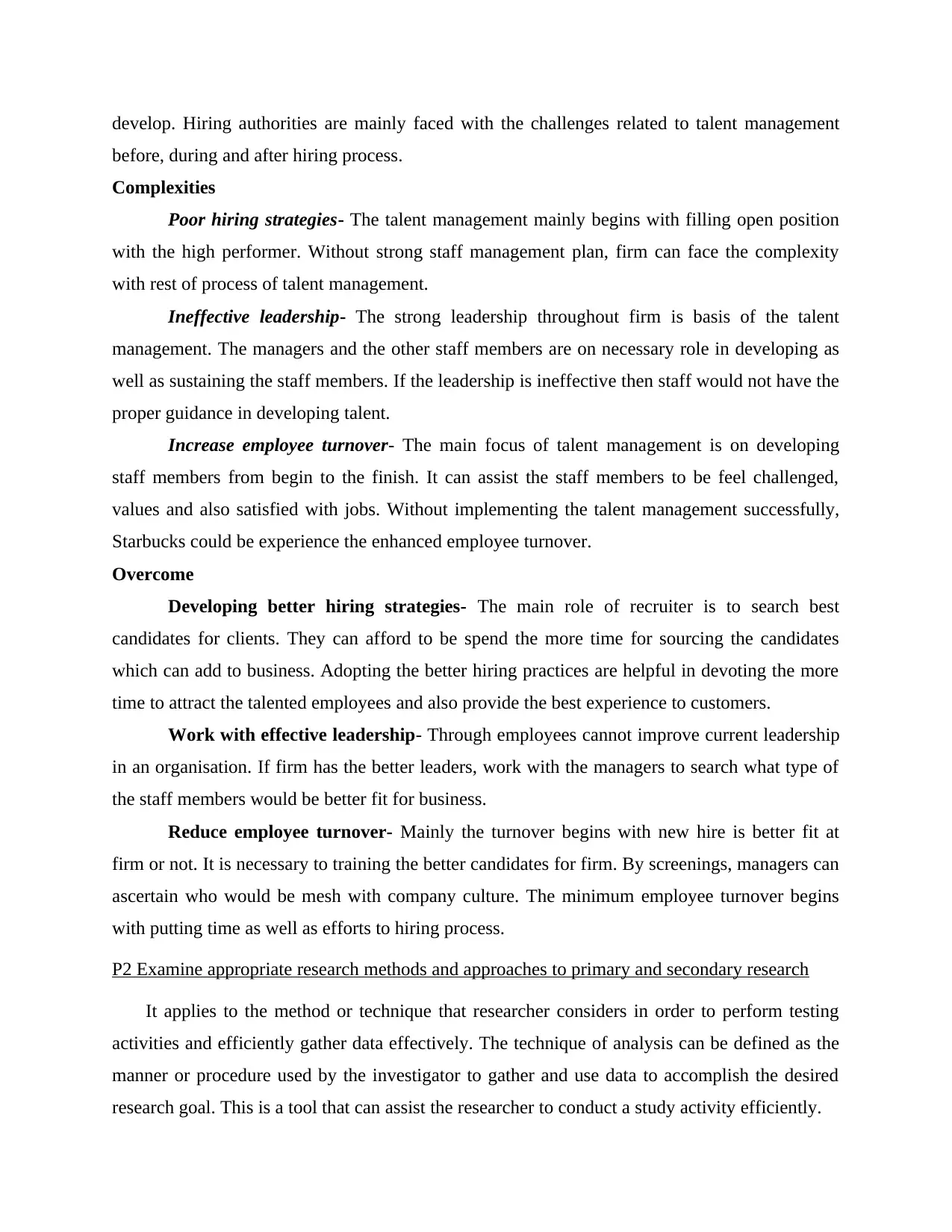
develop. Hiring authorities are mainly faced with the challenges related to talent management
before, during and after hiring process.
Complexities
Poor hiring strategies- The talent management mainly begins with filling open position
with the high performer. Without strong staff management plan, firm can face the complexity
with rest of process of talent management.
Ineffective leadership- The strong leadership throughout firm is basis of the talent
management. The managers and the other staff members are on necessary role in developing as
well as sustaining the staff members. If the leadership is ineffective then staff would not have the
proper guidance in developing talent.
Increase employee turnover- The main focus of talent management is on developing
staff members from begin to the finish. It can assist the staff members to be feel challenged,
values and also satisfied with jobs. Without implementing the talent management successfully,
Starbucks could be experience the enhanced employee turnover.
Overcome
Developing better hiring strategies- The main role of recruiter is to search best
candidates for clients. They can afford to be spend the more time for sourcing the candidates
which can add to business. Adopting the better hiring practices are helpful in devoting the more
time to attract the talented employees and also provide the best experience to customers.
Work with effective leadership- Through employees cannot improve current leadership
in an organisation. If firm has the better leaders, work with the managers to search what type of
the staff members would be better fit for business.
Reduce employee turnover- Mainly the turnover begins with new hire is better fit at
firm or not. It is necessary to training the better candidates for firm. By screenings, managers can
ascertain who would be mesh with company culture. The minimum employee turnover begins
with putting time as well as efforts to hiring process.
P2 Examine appropriate research methods and approaches to primary and secondary research
It applies to the method or technique that researcher considers in order to perform testing
activities and efficiently gather data effectively. The technique of analysis can be defined as the
manner or procedure used by the investigator to gather and use data to accomplish the desired
research goal. This is a tool that can assist the researcher to conduct a study activity efficiently.
before, during and after hiring process.
Complexities
Poor hiring strategies- The talent management mainly begins with filling open position
with the high performer. Without strong staff management plan, firm can face the complexity
with rest of process of talent management.
Ineffective leadership- The strong leadership throughout firm is basis of the talent
management. The managers and the other staff members are on necessary role in developing as
well as sustaining the staff members. If the leadership is ineffective then staff would not have the
proper guidance in developing talent.
Increase employee turnover- The main focus of talent management is on developing
staff members from begin to the finish. It can assist the staff members to be feel challenged,
values and also satisfied with jobs. Without implementing the talent management successfully,
Starbucks could be experience the enhanced employee turnover.
Overcome
Developing better hiring strategies- The main role of recruiter is to search best
candidates for clients. They can afford to be spend the more time for sourcing the candidates
which can add to business. Adopting the better hiring practices are helpful in devoting the more
time to attract the talented employees and also provide the best experience to customers.
Work with effective leadership- Through employees cannot improve current leadership
in an organisation. If firm has the better leaders, work with the managers to search what type of
the staff members would be better fit for business.
Reduce employee turnover- Mainly the turnover begins with new hire is better fit at
firm or not. It is necessary to training the better candidates for firm. By screenings, managers can
ascertain who would be mesh with company culture. The minimum employee turnover begins
with putting time as well as efforts to hiring process.
P2 Examine appropriate research methods and approaches to primary and secondary research
It applies to the method or technique that researcher considers in order to perform testing
activities and efficiently gather data effectively. The technique of analysis can be defined as the
manner or procedure used by the investigator to gather and use data to accomplish the desired
research goal. This is a tool that can assist the researcher to conduct a study activity efficiently.
⊘ This is a preview!⊘
Do you want full access?
Subscribe today to unlock all pages.

Trusted by 1+ million students worldwide
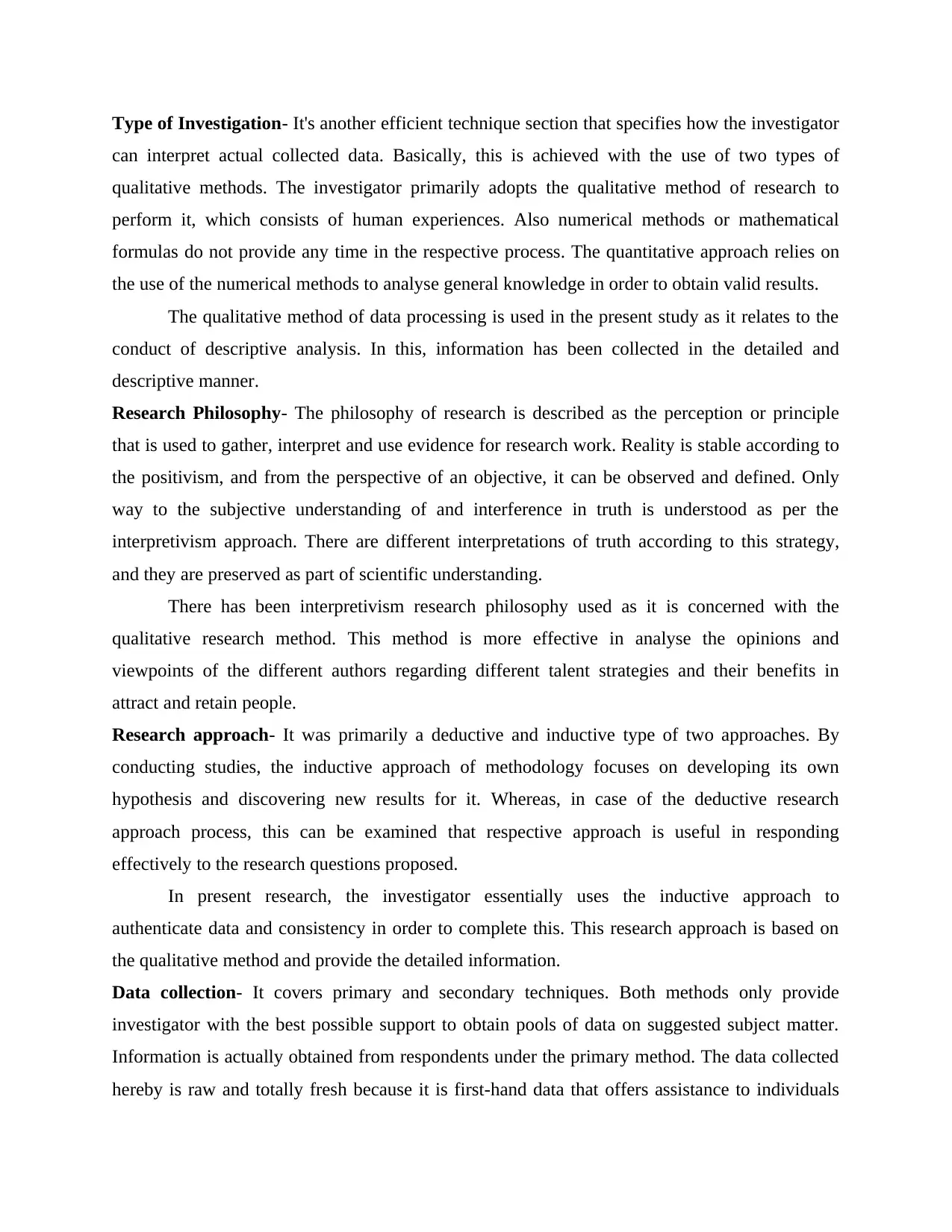
Type of Investigation- It's another efficient technique section that specifies how the investigator
can interpret actual collected data. Basically, this is achieved with the use of two types of
qualitative methods. The investigator primarily adopts the qualitative method of research to
perform it, which consists of human experiences. Also numerical methods or mathematical
formulas do not provide any time in the respective process. The quantitative approach relies on
the use of the numerical methods to analyse general knowledge in order to obtain valid results.
The qualitative method of data processing is used in the present study as it relates to the
conduct of descriptive analysis. In this, information has been collected in the detailed and
descriptive manner.
Research Philosophy- The philosophy of research is described as the perception or principle
that is used to gather, interpret and use evidence for research work. Reality is stable according to
the positivism, and from the perspective of an objective, it can be observed and defined. Only
way to the subjective understanding of and interference in truth is understood as per the
interpretivism approach. There are different interpretations of truth according to this strategy,
and they are preserved as part of scientific understanding.
There has been interpretivism research philosophy used as it is concerned with the
qualitative research method. This method is more effective in analyse the opinions and
viewpoints of the different authors regarding different talent strategies and their benefits in
attract and retain people.
Research approach- It was primarily a deductive and inductive type of two approaches. By
conducting studies, the inductive approach of methodology focuses on developing its own
hypothesis and discovering new results for it. Whereas, in case of the deductive research
approach process, this can be examined that respective approach is useful in responding
effectively to the research questions proposed.
In present research, the investigator essentially uses the inductive approach to
authenticate data and consistency in order to complete this. This research approach is based on
the qualitative method and provide the detailed information.
Data collection- It covers primary and secondary techniques. Both methods only provide
investigator with the best possible support to obtain pools of data on suggested subject matter.
Information is actually obtained from respondents under the primary method. The data collected
hereby is raw and totally fresh because it is first-hand data that offers assistance to individuals
can interpret actual collected data. Basically, this is achieved with the use of two types of
qualitative methods. The investigator primarily adopts the qualitative method of research to
perform it, which consists of human experiences. Also numerical methods or mathematical
formulas do not provide any time in the respective process. The quantitative approach relies on
the use of the numerical methods to analyse general knowledge in order to obtain valid results.
The qualitative method of data processing is used in the present study as it relates to the
conduct of descriptive analysis. In this, information has been collected in the detailed and
descriptive manner.
Research Philosophy- The philosophy of research is described as the perception or principle
that is used to gather, interpret and use evidence for research work. Reality is stable according to
the positivism, and from the perspective of an objective, it can be observed and defined. Only
way to the subjective understanding of and interference in truth is understood as per the
interpretivism approach. There are different interpretations of truth according to this strategy,
and they are preserved as part of scientific understanding.
There has been interpretivism research philosophy used as it is concerned with the
qualitative research method. This method is more effective in analyse the opinions and
viewpoints of the different authors regarding different talent strategies and their benefits in
attract and retain people.
Research approach- It was primarily a deductive and inductive type of two approaches. By
conducting studies, the inductive approach of methodology focuses on developing its own
hypothesis and discovering new results for it. Whereas, in case of the deductive research
approach process, this can be examined that respective approach is useful in responding
effectively to the research questions proposed.
In present research, the investigator essentially uses the inductive approach to
authenticate data and consistency in order to complete this. This research approach is based on
the qualitative method and provide the detailed information.
Data collection- It covers primary and secondary techniques. Both methods only provide
investigator with the best possible support to obtain pools of data on suggested subject matter.
Information is actually obtained from respondents under the primary method. The data collected
hereby is raw and totally fresh because it is first-hand data that offers assistance to individuals
Paraphrase This Document
Need a fresh take? Get an instant paraphrase of this document with our AI Paraphraser
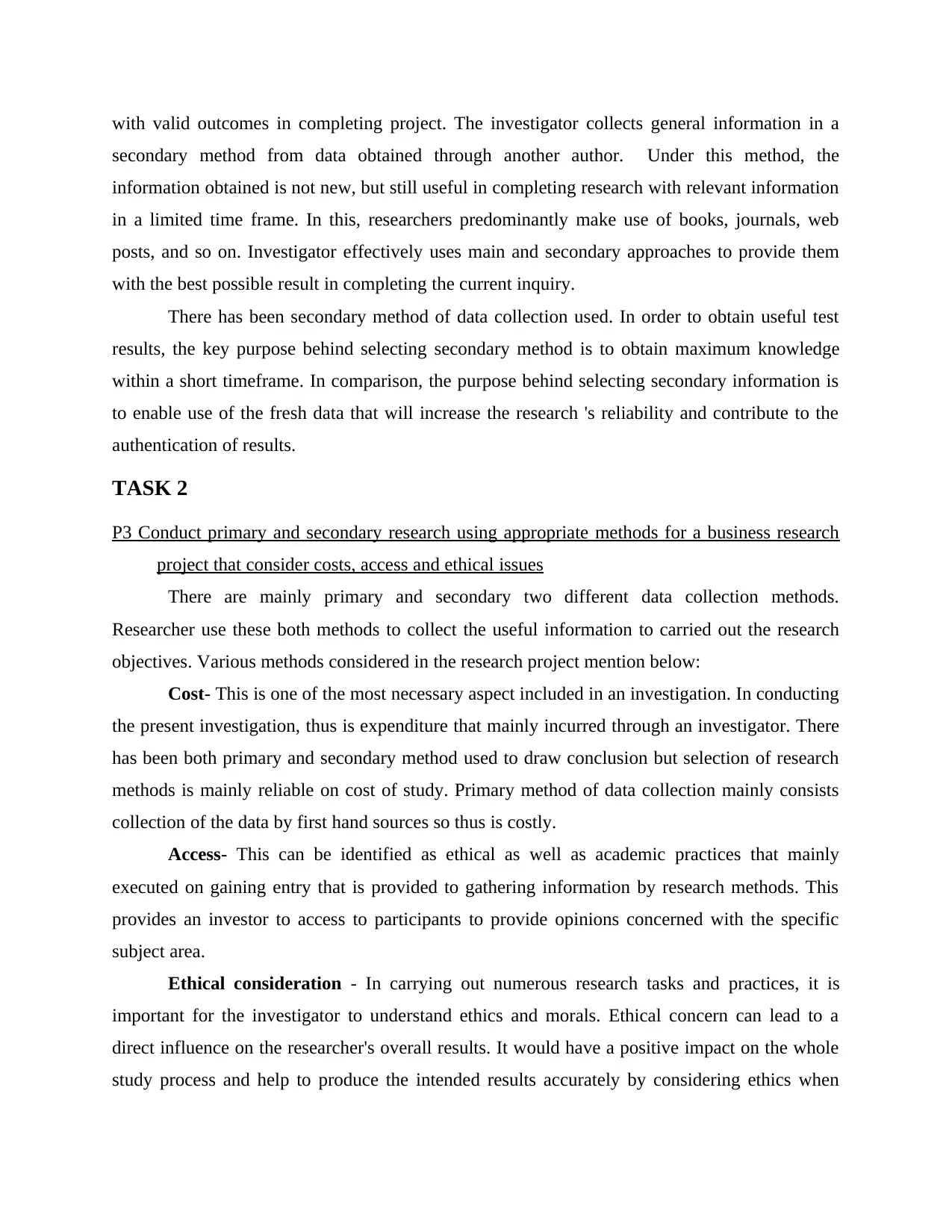
with valid outcomes in completing project. The investigator collects general information in a
secondary method from data obtained through another author. Under this method, the
information obtained is not new, but still useful in completing research with relevant information
in a limited time frame. In this, researchers predominantly make use of books, journals, web
posts, and so on. Investigator effectively uses main and secondary approaches to provide them
with the best possible result in completing the current inquiry.
There has been secondary method of data collection used. In order to obtain useful test
results, the key purpose behind selecting secondary method is to obtain maximum knowledge
within a short timeframe. In comparison, the purpose behind selecting secondary information is
to enable use of the fresh data that will increase the research 's reliability and contribute to the
authentication of results.
TASK 2
P3 Conduct primary and secondary research using appropriate methods for a business research
project that consider costs, access and ethical issues
There are mainly primary and secondary two different data collection methods.
Researcher use these both methods to collect the useful information to carried out the research
objectives. Various methods considered in the research project mention below:
Cost- This is one of the most necessary aspect included in an investigation. In conducting
the present investigation, thus is expenditure that mainly incurred through an investigator. There
has been both primary and secondary method used to draw conclusion but selection of research
methods is mainly reliable on cost of study. Primary method of data collection mainly consists
collection of the data by first hand sources so thus is costly.
Access- This can be identified as ethical as well as academic practices that mainly
executed on gaining entry that is provided to gathering information by research methods. This
provides an investor to access to participants to provide opinions concerned with the specific
subject area.
Ethical consideration - In carrying out numerous research tasks and practices, it is
important for the investigator to understand ethics and morals. Ethical concern can lead to a
direct influence on the researcher's overall results. It would have a positive impact on the whole
study process and help to produce the intended results accurately by considering ethics when
secondary method from data obtained through another author. Under this method, the
information obtained is not new, but still useful in completing research with relevant information
in a limited time frame. In this, researchers predominantly make use of books, journals, web
posts, and so on. Investigator effectively uses main and secondary approaches to provide them
with the best possible result in completing the current inquiry.
There has been secondary method of data collection used. In order to obtain useful test
results, the key purpose behind selecting secondary method is to obtain maximum knowledge
within a short timeframe. In comparison, the purpose behind selecting secondary information is
to enable use of the fresh data that will increase the research 's reliability and contribute to the
authentication of results.
TASK 2
P3 Conduct primary and secondary research using appropriate methods for a business research
project that consider costs, access and ethical issues
There are mainly primary and secondary two different data collection methods.
Researcher use these both methods to collect the useful information to carried out the research
objectives. Various methods considered in the research project mention below:
Cost- This is one of the most necessary aspect included in an investigation. In conducting
the present investigation, thus is expenditure that mainly incurred through an investigator. There
has been both primary and secondary method used to draw conclusion but selection of research
methods is mainly reliable on cost of study. Primary method of data collection mainly consists
collection of the data by first hand sources so thus is costly.
Access- This can be identified as ethical as well as academic practices that mainly
executed on gaining entry that is provided to gathering information by research methods. This
provides an investor to access to participants to provide opinions concerned with the specific
subject area.
Ethical consideration - In carrying out numerous research tasks and practices, it is
important for the investigator to understand ethics and morals. Ethical concern can lead to a
direct influence on the researcher's overall results. It would have a positive impact on the whole
study process and help to produce the intended results accurately by considering ethics when
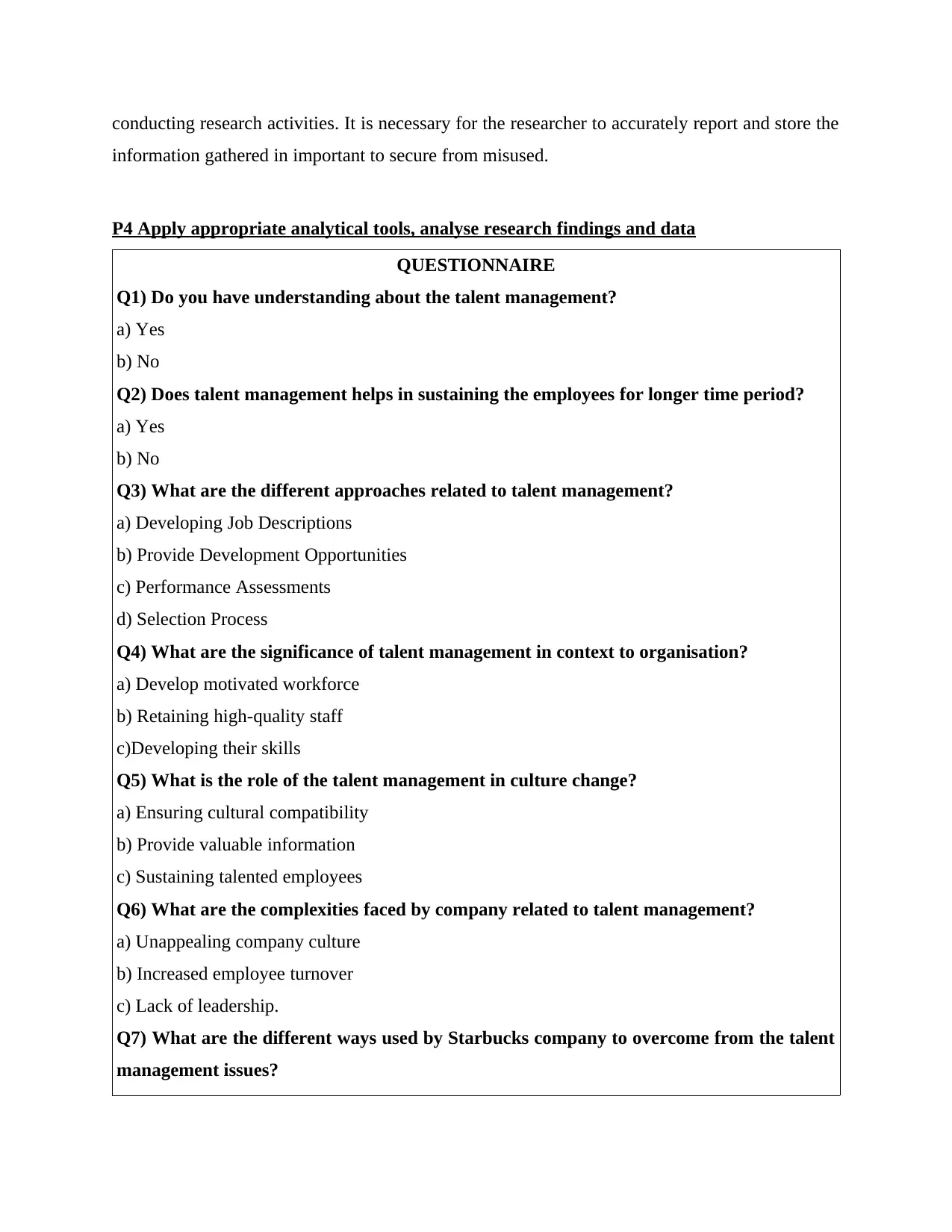
conducting research activities. It is necessary for the researcher to accurately report and store the
information gathered in important to secure from misused.
P4 Apply appropriate analytical tools, analyse research findings and data
QUESTIONNAIRE
Q1) Do you have understanding about the talent management?
a) Yes
b) No
Q2) Does talent management helps in sustaining the employees for longer time period?
a) Yes
b) No
Q3) What are the different approaches related to talent management?
a) Developing Job Descriptions
b) Provide Development Opportunities
c) Performance Assessments
d) Selection Process
Q4) What are the significance of talent management in context to organisation?
a) Develop motivated workforce
b) Retaining high-quality staff
c)Developing their skills
Q5) What is the role of the talent management in culture change?
a) Ensuring cultural compatibility
b) Provide valuable information
c) Sustaining talented employees
Q6) What are the complexities faced by company related to talent management?
a) Unappealing company culture
b) Increased employee turnover
c) Lack of leadership.
Q7) What are the different ways used by Starbucks company to overcome from the talent
management issues?
information gathered in important to secure from misused.
P4 Apply appropriate analytical tools, analyse research findings and data
QUESTIONNAIRE
Q1) Do you have understanding about the talent management?
a) Yes
b) No
Q2) Does talent management helps in sustaining the employees for longer time period?
a) Yes
b) No
Q3) What are the different approaches related to talent management?
a) Developing Job Descriptions
b) Provide Development Opportunities
c) Performance Assessments
d) Selection Process
Q4) What are the significance of talent management in context to organisation?
a) Develop motivated workforce
b) Retaining high-quality staff
c)Developing their skills
Q5) What is the role of the talent management in culture change?
a) Ensuring cultural compatibility
b) Provide valuable information
c) Sustaining talented employees
Q6) What are the complexities faced by company related to talent management?
a) Unappealing company culture
b) Increased employee turnover
c) Lack of leadership.
Q7) What are the different ways used by Starbucks company to overcome from the talent
management issues?
⊘ This is a preview!⊘
Do you want full access?
Subscribe today to unlock all pages.

Trusted by 1+ million students worldwide
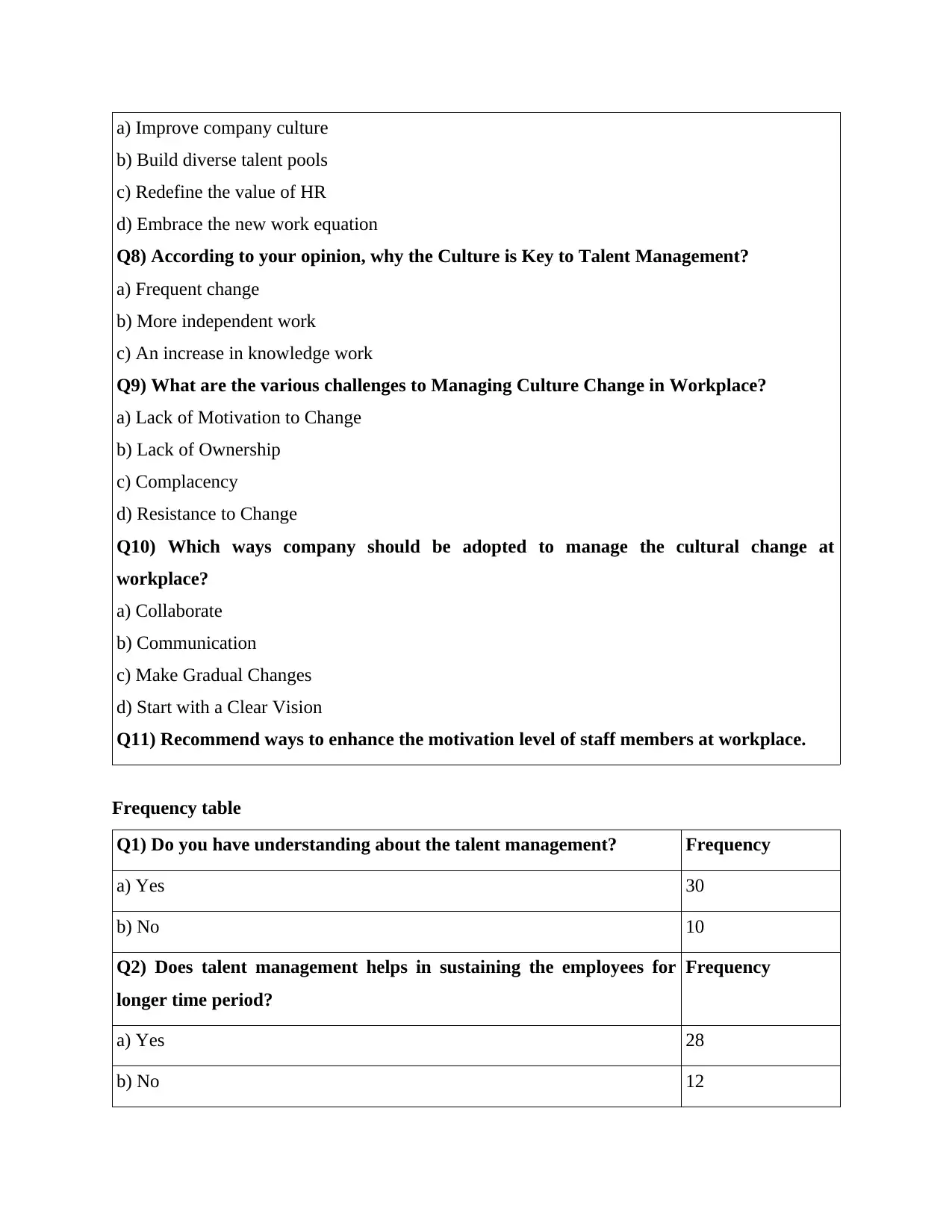
a) Improve company culture
b) Build diverse talent pools
c) Redefine the value of HR
d) Embrace the new work equation
Q8) According to your opinion, why the Culture is Key to Talent Management?
a) Frequent change
b) More independent work
c) An increase in knowledge work
Q9) What are the various challenges to Managing Culture Change in Workplace?
a) Lack of Motivation to Change
b) Lack of Ownership
c) Complacency
d) Resistance to Change
Q10) Which ways company should be adopted to manage the cultural change at
workplace?
a) Collaborate
b) Communication
c) Make Gradual Changes
d) Start with a Clear Vision
Q11) Recommend ways to enhance the motivation level of staff members at workplace.
Frequency table
Q1) Do you have understanding about the talent management? Frequency
a) Yes 30
b) No 10
Q2) Does talent management helps in sustaining the employees for
longer time period?
Frequency
a) Yes 28
b) No 12
b) Build diverse talent pools
c) Redefine the value of HR
d) Embrace the new work equation
Q8) According to your opinion, why the Culture is Key to Talent Management?
a) Frequent change
b) More independent work
c) An increase in knowledge work
Q9) What are the various challenges to Managing Culture Change in Workplace?
a) Lack of Motivation to Change
b) Lack of Ownership
c) Complacency
d) Resistance to Change
Q10) Which ways company should be adopted to manage the cultural change at
workplace?
a) Collaborate
b) Communication
c) Make Gradual Changes
d) Start with a Clear Vision
Q11) Recommend ways to enhance the motivation level of staff members at workplace.
Frequency table
Q1) Do you have understanding about the talent management? Frequency
a) Yes 30
b) No 10
Q2) Does talent management helps in sustaining the employees for
longer time period?
Frequency
a) Yes 28
b) No 12
Paraphrase This Document
Need a fresh take? Get an instant paraphrase of this document with our AI Paraphraser
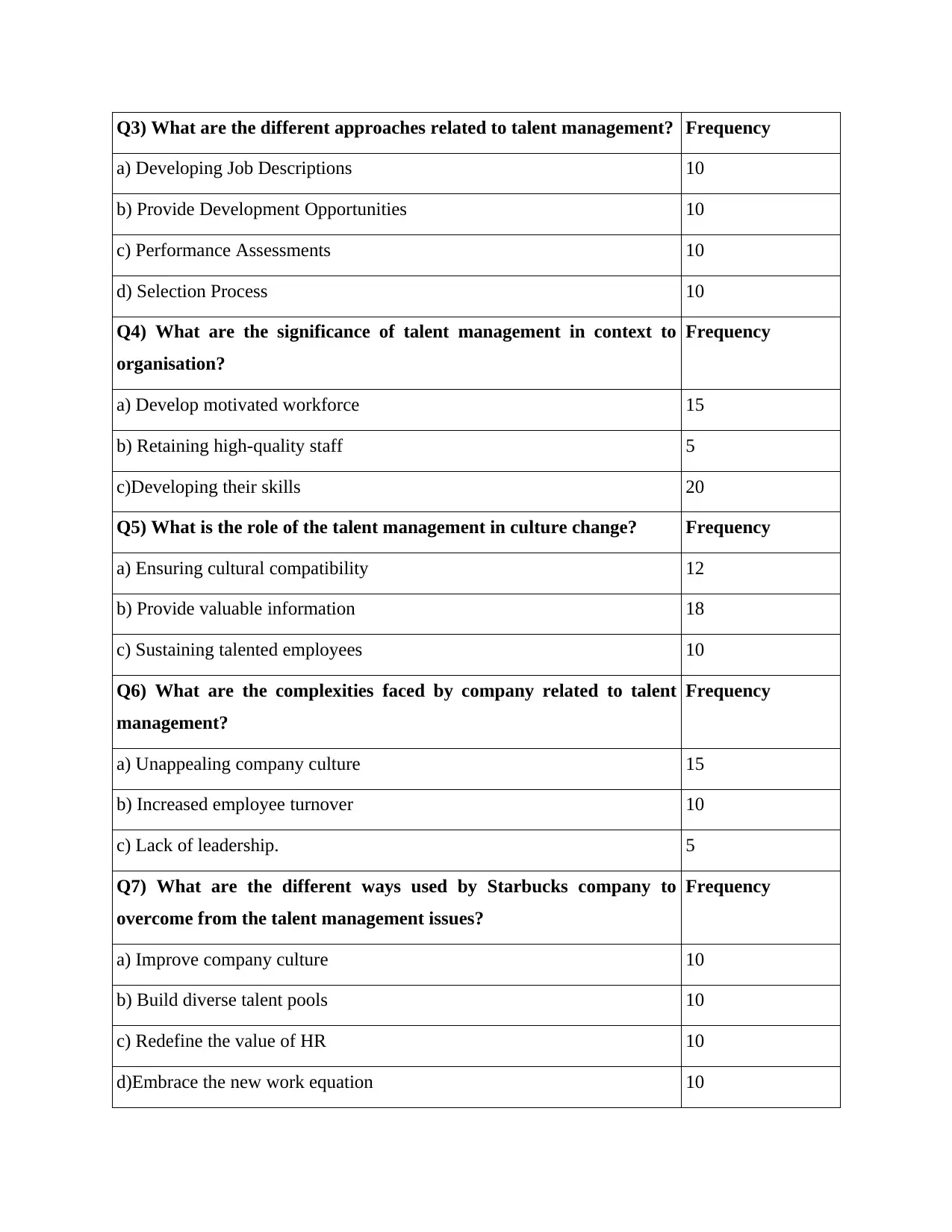
Q3) What are the different approaches related to talent management? Frequency
a) Developing Job Descriptions 10
b) Provide Development Opportunities 10
c) Performance Assessments 10
d) Selection Process 10
Q4) What are the significance of talent management in context to
organisation?
Frequency
a) Develop motivated workforce 15
b) Retaining high-quality staff 5
c)Developing their skills 20
Q5) What is the role of the talent management in culture change? Frequency
a) Ensuring cultural compatibility 12
b) Provide valuable information 18
c) Sustaining talented employees 10
Q6) What are the complexities faced by company related to talent
management?
Frequency
a) Unappealing company culture 15
b) Increased employee turnover 10
c) Lack of leadership. 5
Q7) What are the different ways used by Starbucks company to
overcome from the talent management issues?
Frequency
a) Improve company culture 10
b) Build diverse talent pools 10
c) Redefine the value of HR 10
d)Embrace the new work equation 10
a) Developing Job Descriptions 10
b) Provide Development Opportunities 10
c) Performance Assessments 10
d) Selection Process 10
Q4) What are the significance of talent management in context to
organisation?
Frequency
a) Develop motivated workforce 15
b) Retaining high-quality staff 5
c)Developing their skills 20
Q5) What is the role of the talent management in culture change? Frequency
a) Ensuring cultural compatibility 12
b) Provide valuable information 18
c) Sustaining talented employees 10
Q6) What are the complexities faced by company related to talent
management?
Frequency
a) Unappealing company culture 15
b) Increased employee turnover 10
c) Lack of leadership. 5
Q7) What are the different ways used by Starbucks company to
overcome from the talent management issues?
Frequency
a) Improve company culture 10
b) Build diverse talent pools 10
c) Redefine the value of HR 10
d)Embrace the new work equation 10
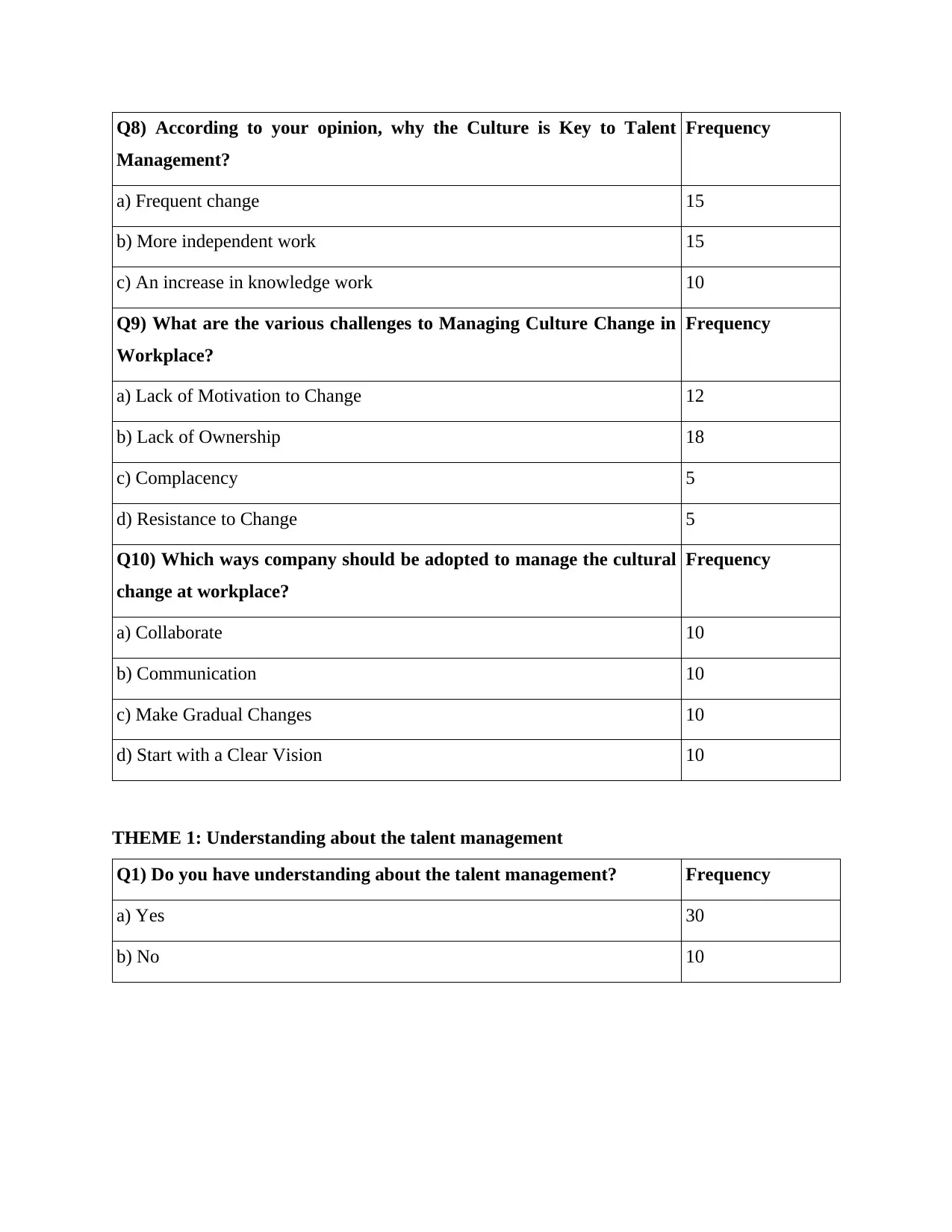
Q8) According to your opinion, why the Culture is Key to Talent
Management?
Frequency
a) Frequent change 15
b) More independent work 15
c) An increase in knowledge work 10
Q9) What are the various challenges to Managing Culture Change in
Workplace?
Frequency
a) Lack of Motivation to Change 12
b) Lack of Ownership 18
c) Complacency 5
d) Resistance to Change 5
Q10) Which ways company should be adopted to manage the cultural
change at workplace?
Frequency
a) Collaborate 10
b) Communication 10
c) Make Gradual Changes 10
d) Start with a Clear Vision 10
THEME 1: Understanding about the talent management
Q1) Do you have understanding about the talent management? Frequency
a) Yes 30
b) No 10
Management?
Frequency
a) Frequent change 15
b) More independent work 15
c) An increase in knowledge work 10
Q9) What are the various challenges to Managing Culture Change in
Workplace?
Frequency
a) Lack of Motivation to Change 12
b) Lack of Ownership 18
c) Complacency 5
d) Resistance to Change 5
Q10) Which ways company should be adopted to manage the cultural
change at workplace?
Frequency
a) Collaborate 10
b) Communication 10
c) Make Gradual Changes 10
d) Start with a Clear Vision 10
THEME 1: Understanding about the talent management
Q1) Do you have understanding about the talent management? Frequency
a) Yes 30
b) No 10
⊘ This is a preview!⊘
Do you want full access?
Subscribe today to unlock all pages.

Trusted by 1+ million students worldwide
1 out of 27
Related Documents
Your All-in-One AI-Powered Toolkit for Academic Success.
+13062052269
info@desklib.com
Available 24*7 on WhatsApp / Email
![[object Object]](/_next/static/media/star-bottom.7253800d.svg)
Unlock your academic potential
Copyright © 2020–2025 A2Z Services. All Rights Reserved. Developed and managed by ZUCOL.





